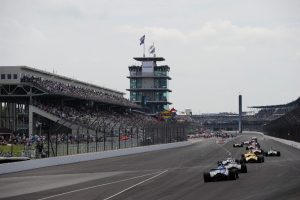
Photo: Indianapolis Motor Speedway/LLC Photography
Three championships (and 20 feeders), 73 drivers (plus 400 more in the feeder ranks), and a guarantee that one of them every year will qualify for the Indianapolis 500.
The Mazda Road to Indy is one of the biggest success stories in motorsport, and that’s including the achievements of competitors and organising bodies.
It’s unusual, bordering on the insane, that a major car firm funds and supports junior motorsport categories to the degree that Mazda does, especially when the Japanese manufacturer does not supply hardware to any IndyCar teams. Any advertisement of Mazda’s IndyCar success could be seen as misleading.
But what a success it has been, one that broke another ceiling last year when MRTI graduate Josef Newgarden won the IndyCar title.
“I?m pretty happy with it. If you look at last year?s Indianapolis 500 starters, I think out of 33 drivers we had something like 25 of them that have come through MRTI,” said Michelle Kish, the chief operating officer of MRTI, when Formula Scout spoke with her at the Autosport International Show.
The drivers ranged from 20th century Indy Lights competitors Scott Dixon, Tony Kanaan and Helio Castroneves (in the pre-Mazda era) to 2016 champion Ed Jones, who went on to finish third in his first Indy 500 start.

“While Josef may be the first champion, we?ve had multiple winners, Indy 500 rookies of the year, and lots and lots of starters.
“When you?re talking about a programme that graduates potentially a lot of drivers each year, to a series that they stay in once they get there, it?s hard to consistently be able to provide those drivers a good seat. There?s only so many seats.”
The limited number of seats is a frequently used excuse in Formula 1 for the lack of drivers entering from the feeder categories, something that young driver programmes like Red Bull’s have alleviated to an extent. There is a greater incentive for teams to choose talent in IndyCar, as the lower budgets means more drivers are able to raise the required money. Oh, and Mazda gives $1 million to the Indy Lights champion.
“Every year, we?re just happy that so many have been able to find a seat, succeed in IndyCar and have a career. Some of them shorter than others, but I think that what we?ve proven is that the system works and we?ve given them all the tools that we can, to get them to the place where it?s now on them to see how they perform when they get there.”
In 2016 the MRTI Shootout was introduced, a two-day event in which drivers from entry-level single-seater championships across the globe competed for a $200,000 scholarship into USF2000.
“If you go back in the history of it [MRTI], they were giving the $200,000 scholarship, but it was given to the Skip Barber champion in the day. That?s not part of MRTI specifically, it was kind of a peripheral.
“When that partnership ended, we had some conference calls and decided [on the feeder championships].
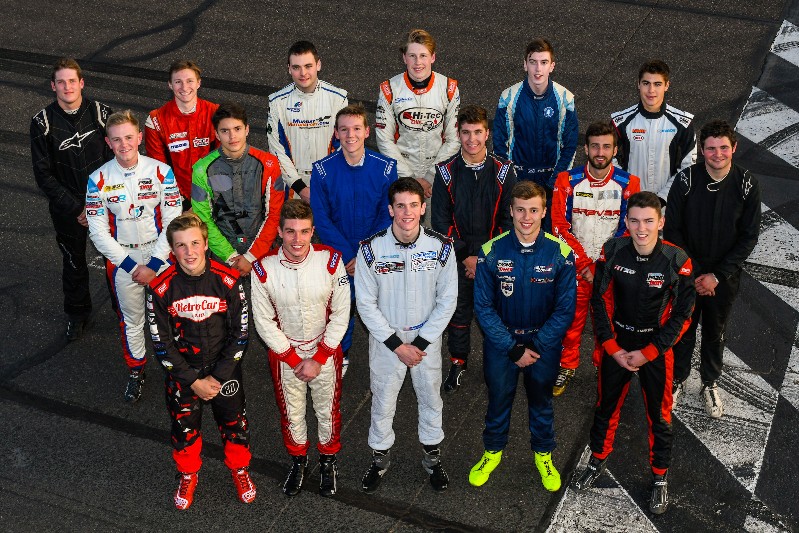
Photo: Indianapolis Motor Speedway/LLC Photography
“The partnerships worldwide help them and help us, because we?re able to provide these series around the world with an opportunity for their drivers that they would never had, to move up. Those drivers are more aware of the opportunities that are here, [previously] they might have been nervous of coming over to another continent.
“I love the programme, I love that we?re making these relationships with these other series, and that everybody?s starting to say: ?Hey, maybe the F1 opportunity isn?t here?. IndyCar is a real opportunity, and it has worked for so many drivers so I think it?s given a lot of drivers the hope that really, even if their budget is not there, if they win and they do well, people are noticing them. They really do still have an opportunity to be professional drivers.”
Partnerships and relationships are an integral part to the success of the MRTI, and one of the latest ones is with Tatuus, manufacturer of the new Pro Mazda and USF2000 cars.
“The US-17 [the USF2000 car introduced last year], which was the first one done on the new platform, was actually based on Tatuus?s F4 chassis, but with a bunch of safety modifications for running on ovals and street races, like side-intrusion panels in the crash box and the nose.
“It came from that platform, and then what we wanted to do was make it so that it could be adapted to a Pro Mazda version, so that if someone owns the tub they can do either. Or they may even be able to grow with their team or driver to the next series. So it becomes more equivalent to the [BRDC British] F3, and that was how that chassis and car developed.

Photo: Indianapolis Motor Speedway/LLC Photography
“I think there?s enough differences though in the States with our program, because of the street races and ovals, that it does make it somewhat unique, and it?s never going to be a completely same road course car. If you?ve been to the street races in the States, some of them are worse than the ovals as far as I?m concerned [in terms of] the harshness on the vehicle. They can be so bumpy.
“Some less well-made cars can break suspension pieces just hitting bumps. It?s so hard on the equipment, so we wanted to make sure that it was, in a lot of ways, a better car. Not that the F3 cars aren?t good cars, they?re good for what they are, but for what we need it to be, it has enough differences that it would not be able to sustain the kind of wear and tear we put it through.”
Not only can drivers run in two different tiers with essentially the same kit, they benefit from being in the same paddock as IndyCar, a dissimilar setup to that of F1’s feeders, where nothing is shared bar the track.
“It?s really cool and it?s one of the things that a lot of drivers say they?re surprised about. I?ve been to Silverstone for F1, and when Conor Daly was doing GP3, I was able to get into the paddock where even he couldn?t go.
“In MRTI and IndyCar the paddock is very very open. And these guys [IndyCar drivers] watch us. They watch our drivers on the track, especially when you have teams like Andretti, with multiple levels. They?re in each other’s paddocks all the time and the drivers all become very friendly.
“It?s kind of interesting, even with such a large country, that so many drivers live in Indianapolis. That they all go to the same gym, that they all go to the same lake on weekends and go wakeboarding. It?s a small community and no matter what happens on the track, most of them are really good friends off the track.
“It’s not very snobby. I?m sure some [IndyCar drivers] have big egos, but they?re not like: I?m not going to talk to you. They talk to everybody.”
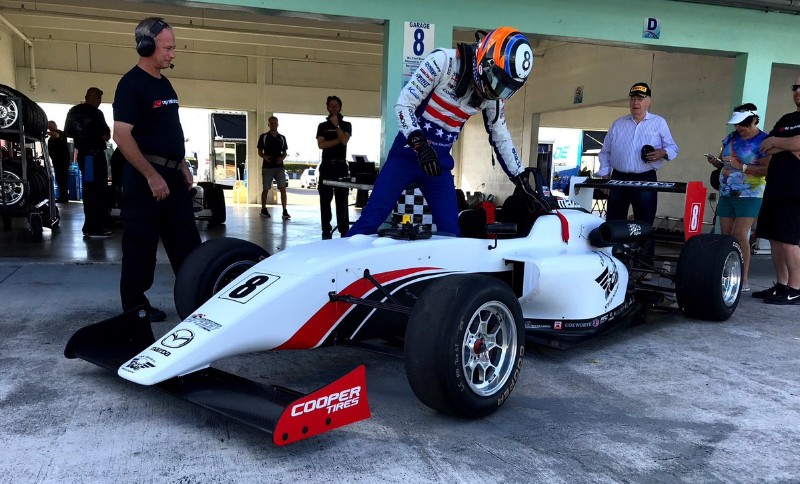
MRTI does not have a monopoly on junior single-seaters in America, as the FIA has set up its own F3 and F4 series. There are many national and local governing bodies that sanction series at a lower level, most of which now act as MRTI feeders, although the Lucas Oil School of Racing has a rival scholarship to USF2000 that offers $100,000.
“We are always looking to grow the field, but right now I don?t really understand why we need so many small open-wheel championships in America. There?s US F4, and they?ve announced F3. It seems to be just weakening the playing field. Why aren?t we just focusing on the system that works?
“I think their original appeal was theoretically less budget, but from what I?m hearing now, it?s really not anymore. So I just don?t know why we can?t just say: hey, this [MRTI] is the system that works, and let?s just get all the drivers that have open-wheel aspirations to just use that rather than muddy the waters.
“We?ve had discussions with those guys in that series too, it?s not an unfriendly relationship either, it?s just that it seemed unnecessary to me to have multiple lower-level championships. We want to get the kids the opportunity, but not get them confused over where to race.”
Although unlikely to be a consequence of US F4’s arrival, MRTI grid sizes haven’t been the strongest in recent years.
“It?s funny. Years ago, we had a grid limit, I think it was at St. Petersburg, just because of the paddock space. We had an upper limit of 37 cars or something like that. So at certain events, because the street races are temporary circuits, you only have so much space.
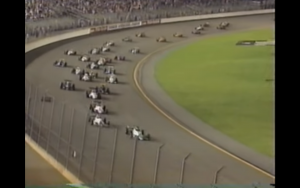
A shot from footage of the 1995 Richmond USF2000 race which attracted 32 starters, a low for that season
“At Mid-Ohio in 1995 [the first year of the unified championship], USF2000 started 60 cars. They had National Class as well back then. And to me that?s a little crazy, especially at a track where you can?t pass.”
“Like anything, it?s more about the quality of the field than the quantity. If we had a 20 car field, and only two or three of them were any good, I think that would obviously lower the value. I think one of the things we have had is pretty good depth of field in some classes. Pro Mazda last year ended up being a two-horse race at the end of the day, but that was a transition year before this [PM-18] car.”
The 2018 Pro Mazda grid has already proven to be the MRTI championship to watch this year, and the new car has been part of the improved spectacle. One other change that Pro Mazda teams may appreciate is a race on the Indianapolis Motor Speedway oval. The lower two championships race at Lucas Oil Raceway, although this did not take place last year, whilst Indy Lights has used IMS for the Freedom 100, the race every MRTI driver wants to win.
“What we?re trying to do is expose the drivers to the tracks that IndyCar is running on. I don?t know if if [making a trophy race for the lower classes] would be something that we would do on one of those tracks already, as a special event.
“Right now, Indy Lights has that race. The lower levels use LOR. I don?t think that?s a big enough venue for them. The big ones, the bigger events that automatically draw [in entries] are places like St. Pete, places people want to go, and especially at the beginning of the year. Right now that [trophy races] is not on the radar, but it?s an interesting thought.”
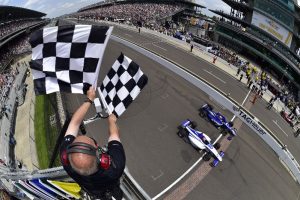
Photo: Indianapolis Motor Speedway/LLC Photography
St. Pete is one of several street circuits on the MRTI calendar, with only Formula 2 and European F3 rivalling the ladder for volume of them. Add ovals, and MRTI has some of the most varied calendars in the motorsport world; ideal for young drivers wanting to expand their skill set. However the advertised dangers of oval racing, and the decision by former IndyCar driver Mike Conway to forgo them, has changed attitudes towards their benefits in junior formulae.
“There?s a lot of rumblings that are people are scared of ovals. They don?t want to do ovals. But if I?m being honest, I think we do more damage to the cars on the street circuits than we do on the ovals. Yes if you do hit big on the ovals it?s a big hit. But we?ve, touch wood, had some very clean races in the lower levels, especially on the ovals.
“Some of the street races, the cars can get mangled up because there’s no runoff. Some of those corners narrow down really really quickly, and if you get two or three wide in there: boom.
“I feel like [street circuits] hasn?t been a deterrent, but I don?t know if it?s been a specific attraction, other than if they have a partner or somebody who wants to be at that event, because as an event goes, the street races, I think, are awesome.
“As a track, some drivers have ones they love and not, but there are a lot of purists out there who want a Road America, or?a nice long Barber. Those are usually ones the drivers say they want to drive on. As an event goes, those tracks also do a good job, but the street races have a different kind of vibe.
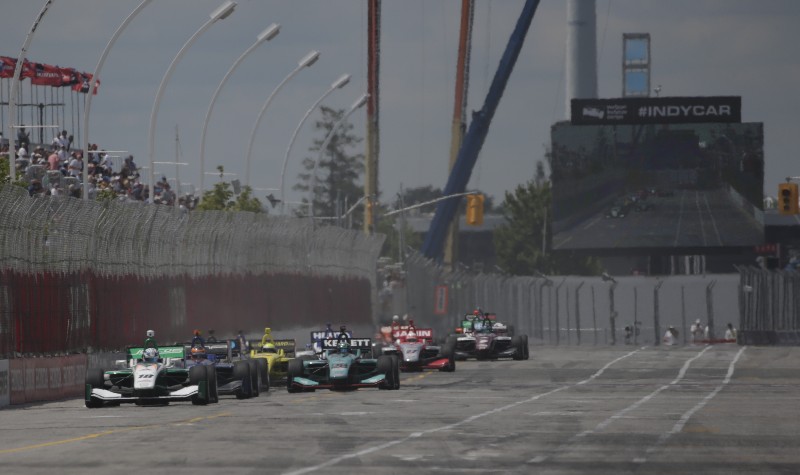
Photo: Indianapolis Motor Speedway/LLC Photography
“I don?t know if it?s something they?d specifically come to the series for, but I think the mix of all three types of circuit is a training that you can?t get anywhere else. Because you?re only learning one style of racing, essentially, if you?re racing somewhere else.”
Racing across North America costs money, something which comes up in questions a lot for Kish.
“We?ve actually put this out there because the question comes up so much. We say $1 million to $1.2 million for Lights. Obviously it depends on testing and everything else, but $525k to $625k for Pro Mazda and $275k to $375k for USF2000. I mean, some of these figures are wide, because it depends on so many factors.
“Sometimes, a team is based where our schedule means they have to travel more. Their travel budget is higher than another team. Sometimes a driver wants to do more private testing, sometimes it includes x, y and z, sometimes it doesn?t.
“There is [a limit on testing]. There?s a blackout period, and all three categories only have a certain amount of days in a season.?For private tests, they can?t test at a track we?re going to race at that season until after we?ve raced there.
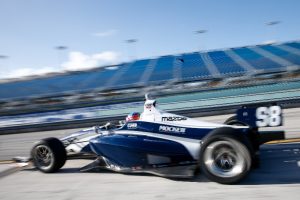
Photo: Indianapolis Motor Speedway/LLC Photography
“Indy Lights has some special exceptions.?If they have a new driver that they want to sign in the middle of the season or something, they?re allowed a driver evaluation day. There?s a few exceptions, but it?s limited obviously to keep the budgets in check. We still want them to get track time though.”
There’s a loophole in the testing regulations which allows Pro Mazda teams unlimited running with a USF2000 driver, for example.
“With all of these rules you know, it sounds like a good idea and then somehow when it?s implemented somebody finds some way to make it not work well, and then you have to look at it again. But right now, it looks like it?s working well.
“It?s funny. They?ll complain to us that they?re spending too much money. They don?t have to, but they feel like they do because somebody else is. Even if it doesn?t really help them that much, [they?ll pursue it].
MRTI provides media and other forms of off-track training, but it is the cars that prepares drivers best for IndyCar.
The same data system is used all the way up, for ease-of-use, and the new IndyCar bodykit has been praised by Indy Lights drivers for simplifying the transition. The one big difference is the tyres. IndyCar uses Firestone, and MRTI uses Cooper. But Kish doesn’t see this negatively.
“The Cooper partnership is like a backbone of MRTI. They?re awesome, they really are. They will step in, any time when there is anything of concern, and they will put in the time and the effort and the money to make it right. They?re excellent.”
1 GBP = 1.41 USD at the time of interview.